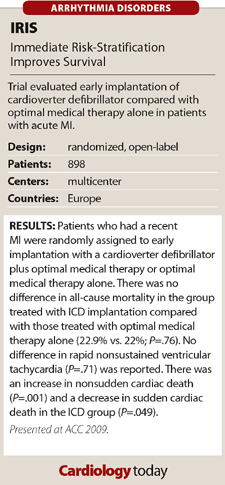IRIS: ICD implantation did not offer benefit at one month following MI
No subgroup benefited from early defibrillator implantation.
Early implantation of a cardioverter defibrillator did not increase survival when compared with optimal medical therapy.
Researchers for the IRIS study enrolled 898 patients with recent acute MI and randomly assigned 445 to ICD implantation plus optimal medical therapy and 453 to optimal medical therapy alone. The primary endpoint was all-cause mortality.
The researchers reported no difference in all-cause mortality in the group treated with ICD implantation compared with those treated with optimal medical therapy alone (22.9% vs. 22%; P=.76). They also reported no difference in rapid nonsustained ventricular tachycardia (P=.71), as well as an increase in nonsudden cardiac death (P=.001). There was a decrease in sudden cardiac death in the ICD group (P=.049).
“In a carefully selected, post-MI study group with moderately reduced ejection fraction, all-cause mortality and sudden cardiac death — because of the risk stratification that we applied — were substantial,” Gerhard Steinbeck, MD, chairman of cardiology at the University of Munich in Germany, said. “Nevertheless, early initiation of ICD therapy in this high-risk cohort did not reduce all-cause mortality independent of the way risk stratification was applied.” – Eric Raible

For more information:
- Steinbeck G. #416. Presented at: American College of Cardiology 58th Annual Scientific Sessions; March 29-31, 2009; Orlando, Fla.

![]()
The concern for me in this trial was that a number of the patients were not necessarily indicated for an ICD in the first place, based on ejection fraction and nonsustained injury for tachycardia alone. We have data for ICDs such as from MUSTT for ejection fraction of 40% and MADIT I for ejection fraction of 35%, with nonsustained ventricular tachycardia. In this study’s second group, the patients had a mean ejection fraction of about 45%, so they would not necessarily have a nonsustained ventricular tachycardia indication for an ICD. I am still left with the question of how to approach the patient with a large infarct, significantly depressed ejection fraction, and I wonder whether it would not potentially be a benefit for that patient to have an ICD early if it indeed were paid for.
– Richard L. Page, MD
Professor and Head of Cardiology, University of Washington School of Medicine, Seattle
